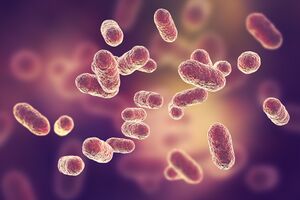User:Rogers3: Difference between revisions
| Line 2: | Line 2: | ||
[[Image:PHIL_22882_lores.jpg|thumb|300px|right|This illustration depicts a three-dimensional (3D), computer-generated image, of a group of Gram-positive, Streptococcus agalactiae (group B Streptococcus) bacteria. The photo credit for this image belongs to Alissa Eckert, who is a medical illustrator at the [http://www.cdc.gov/ CDC].]] | [[Image:PHIL_22882_lores.jpg|thumb|300px|right|This illustration depicts a three-dimensional (3D), computer-generated image, of a group of Gram-positive, Streptococcus agalactiae (group B Streptococcus) bacteria. The photo credit for this image belongs to Alissa Eckert, who is a medical illustrator at the [http://www.cdc.gov/ CDC].]] | ||
<br><b>By Emily Rogers</b> | <br><b>By Emily Rogers</b> | ||
<br>Bioterrorism is defined as using “using biological agents to inflict disease and/ or death on humans, animals or plants, and motivations for pursuing such an attack could have religious, political, or criminal motivations.”<ref name=s1>[https://journals.asm.org/doi/full/10.1128/CMR.14.2.364-381.2001 Klietmann, W., & Ruoff, K. (2001). Bioterrorism: Implications for the Clinical Microbiologist. Clinical Microbiology Reviews, 14(2).]</ref> People that plan and perform bioterrorism attacks could also be a part of nationalist, separatist, or apocalyptic cult groups. Biological agents can also be used by military and government agencies in warfare. Early records of bioterrorism in the 14th century include the Tartar group attacking the city Kaffa by catapulting cadavers infected with the plague, caused by the bacteria Yersinia pestis, over the walls of the city, causing the plague to spread over the Mediterranean. More recently in 1984, a cult following the Rajneeshee movement poisoned a restaurant in Oregon with Salmonella bacteria because they had political motives to win an election. Unlike other types of terror attacks, bioterrorism has the unique ability to go undetected for a severe length of time, in which infected individuals can spread the agent even further, before the attack event is even detected.<br><br>The insertion code consists of: | <br>Bioterrorism is defined as using “using biological agents to inflict disease and/ or death on humans, animals or plants, and motivations for pursuing such an attack could have religious, political, or criminal motivations.”<ref name=s1>[https://journals.asm.org/doi/full/10.1128/CMR.14.2.364-381.2001 Klietmann, W., & Ruoff, K. (2001). Bioterrorism: Implications for the Clinical Microbiologist. Clinical Microbiology Reviews, 14(2).]</ref> People that plan and perform bioterrorism attacks could also be a part of nationalist, separatist, or apocalyptic cult groups.<ref name=s2>[http://clsjournal.ascls.org/content/ascls/15/1/6.full.pdf Poupard J. A. and Miller L. A. History of biological warfare: catapults to capsomeres. Ann. N.Y. Acad. Sci. 666 1992 9 -20]</ref> Biological agents can also be used by military and government agencies in warfare. Early records of bioterrorism in the 14th century include the Tartar group attacking the city Kaffa by catapulting cadavers infected with the plague, caused by the bacteria Yersinia pestis, over the walls of the city, causing the plague to spread over the Mediterranean. More recently in 1984, a cult following the Rajneeshee movement poisoned a restaurant in Oregon with Salmonella bacteria because they had political motives to win an election. Unlike other types of terror attacks, bioterrorism has the unique ability to go undetected for a severe length of time, in which infected individuals can spread the agent even further, before the attack event is even detected.<br><br>The insertion code consists of: | ||
<br><b>Double brackets:</b> [[ | <br><b>Double brackets:</b> [[ | ||
<br><b>Filename:</b> PHIL_1181_lores.jpg | <br><b>Filename:</b> PHIL_1181_lores.jpg | ||
Revision as of 16:35, 14 April 2023
Introduction to Bioterrorism

By Emily Rogers
Bioterrorism is defined as using “using biological agents to inflict disease and/ or death on humans, animals or plants, and motivations for pursuing such an attack could have religious, political, or criminal motivations.”[1] People that plan and perform bioterrorism attacks could also be a part of nationalist, separatist, or apocalyptic cult groups.[2] Biological agents can also be used by military and government agencies in warfare. Early records of bioterrorism in the 14th century include the Tartar group attacking the city Kaffa by catapulting cadavers infected with the plague, caused by the bacteria Yersinia pestis, over the walls of the city, causing the plague to spread over the Mediterranean. More recently in 1984, a cult following the Rajneeshee movement poisoned a restaurant in Oregon with Salmonella bacteria because they had political motives to win an election. Unlike other types of terror attacks, bioterrorism has the unique ability to go undetected for a severe length of time, in which infected individuals can spread the agent even further, before the attack event is even detected.
The insertion code consists of:
Double brackets: [[
Filename: PHIL_1181_lores.jpg
Thumbnail status: |thumb|
Pixel size: |300px|
Placement on page: |right|
Legend/credit: Electron micrograph of the Ebola Zaire virus. This was the first photo ever taken of the virus, on 10/13/1976. By Dr. F.A. Murphy, now at U.C. Davis, then at the CDC. Every image requires a link to the source.
Closed double brackets: ]]
Other examples:
Bold
Italic
Subscript: H2O
Superscript: Fe3+
Sample citations: [3]
[4]
A citation code consists of a hyperlinked reference within "ref" begin and end codes.
To repeat the citation for other statements, the reference needs to have a names: "<ref name=aa>"
The repeated citation works like this, with a forward slash.[3]
Section 1
Include some current research, with at least one figure showing data.
Every point of information REQUIRES CITATION using the citation tool shown above.
Section 2
Include some current research, with at least one figure showing data.
Section 3
Include some current research, with at least one figure showing data.
Section 4
Conclusion
References
- ↑ Klietmann, W., & Ruoff, K. (2001). Bioterrorism: Implications for the Clinical Microbiologist. Clinical Microbiology Reviews, 14(2).
- ↑ Poupard J. A. and Miller L. A. History of biological warfare: catapults to capsomeres. Ann. N.Y. Acad. Sci. 666 1992 9 -20
- ↑ 3.0 3.1 Hodgkin, J. and Partridge, F.A. "Caenorhabditis elegans meets microsporidia: the nematode killers from Paris." 2008. PLoS Biology 6:2634-2637.
- ↑ Bartlett et al.: Oncolytic viruses as therapeutic cancer vaccines. Molecular Cancer 2013 12:103.
Authored for BIOL 238 Microbiology, taught by Joan Slonczewski, 2023, Kenyon College
